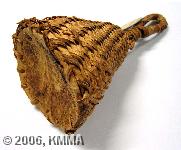
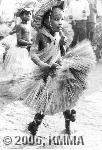
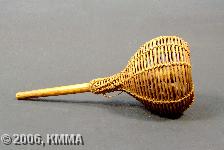
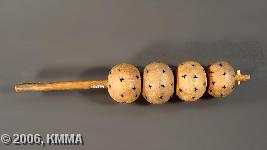
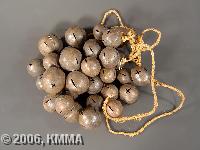
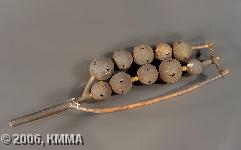
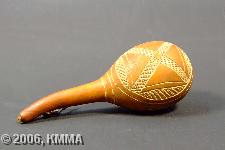
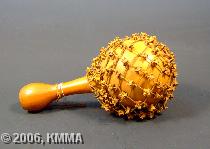
The rattle is a shaken idiophone that is very common in Africa. The variety of types, materials, method of playing, and timbre is extremely wide. The distinct types dealt with here are: the calabash rattle, spherical rattle, box rattle, basket rattle, tin rattle, and ankle rattle. The variety within this category of instruments is so large that we tend to think that every tribe in the Congo has its own typical rattles, all of which are made from plant material. The timbres in one type of rattle can also vary considerably according to the material chosen to put into the sound box: small stones create a hard, sharp sound, while softer grains produce a warmer sound.
First there are the calabash rattles: they are used particularly in rituals that involve magic and religion. For this reason one frequently finds them among magic healers or followers of cults and other societies. The most common type is the calabash rattle where the neck of the calabash is used as a handle. In order to make this rattle, the neck is cut and a stick is inserted into the opening created to serve as a handle. Before the stick is attached, plant pips or large seeds are placed in the hollow space. By shaking the instrument one obtains a very penetrating sound and creates a rhythmic pattern at the same time. It is not unusual for calabash rattles to be decorated with coloured (red, white, and yellow) geometrical patterns. Often the large round calabash is also transformed into a musical instrument by removing the flesh of the plant and replacing it with seeds, small stones, fruit cores and suchlike, after which neck opening is re-closed. In contrast to the previous type, this calabash rattle is used in an ensemble that provides the accompaniment to musical entertainment. The sound produced is also much gentler than the penetrating sound of the rattle with a handle.
The spherical rattle is related to the calabash rattle but the sound box is not a pear-shaped calabash but a smaller round seedpod. The seedpod is dried, hollowed out, filled with small particles and mounted on a handle. There are often small openings burnt into the edge of the seedpod, sometimes coupled with geometric figures and lines. The simplest form is where one seedpod is placed on a handle, but frequently several are mounted onto one single handle, and at times a handle with several branches is used on which to mount seed pods.
The third type of rattle that is common in the Congo is the basket rattle, where the spherical calabash is replaced with a woven structure. What is most striking here is the very ingenious and elegant way in which this weaving is done, a real testimony to skilled craftsmanship. The form obtained and also the method of weaving varies greatly. Some basket rattles are reminiscent of woven handbags, others are spherical, where the sound box imitates the shape of a calabash. Here in this last example, a handle is mounted and sometimes at the other end a second basket is woven forming a double basket rattle. These instruments are used primarily by women to provide rhythm for the dance music, but due to their rather soft body, the sound delivered is significantly less loud than the typical calabash rattle.
Moreover, the inventiveness of the manufacture of musical instruments from sub-Saharan Africa is particularly apparent in the rattles that take the form of a woven "box"; the box rattle. The principle is actually quite simple: thin reed sticks are tied together until a flat sound box is formed. The box is then filled with different types of plant matter. The women who play this instrument hold it with both hands and shake it in a horizontal direction.
Occasionally rattles are also made by recycling old tin cans. The tin rattle is filled with seeds or stones and then closed up and sometimes small holes are made. The instrument is simple and not as aesthetically pleasing as the other types of rattle, but due to its sharp and hard timbre (the sound is produced by small stones hitting the metal) it is very popular.
Up to this point, all the rattles that have been discussed have been hand-held in order to create rhythm, as opposed to those that are tied to a musician’s or dancer’s arm, wrist or ankle. Here too, we should note that these instruments are also made primarily from plant materials.
Fruit seeds and pips are preferred and are often used whole or sliced through the middle, tied in a bunch or on a string, or secured to a frame which is attached to the dancer’s wrist or ankle. As a result of the rhythmic movements the dancers make with their feet while dancing or with their hands while drumming, the instrument provides an additional rhythmic element. Most remarkable is the care and artistry put into making the instrument.
The weaving that plays such an important role in the material culture of the Congolese tribes ensures that these rhythmic instruments are even more visually attractive.
This type of instrument is used in recordings of our sound archives made with the Congolese peoples mentioned hereafter where it appears with the following vernacular names:
Tshaku-tshaku (Kongo), Tshotsha (Tshokwe), Wanga (Ngbaka), Wango (Lobala), Yashi (Leele), Yatsh (Kuba), Yele (Bayele) (Nyari), Zeze (Ng'bandi)
Discography:
© KMMA